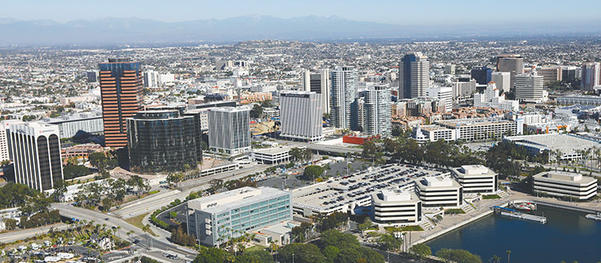Finding the right location in a downtown area for an office or storefront can be a daunting task for a new business, and even an established one entering a new city.
When it comes to office space, Downtown Long Beach buildings are broken into A, B and C Class. According to Toliver Morris, owner and president of William Morris Commercial, Class C buildings are typically older, built in the early 1900s; Class B buildings were built between the 1960s and early 1980; and the three Class A buildings – World Trade Center, Landmark Square and Shoreline Square – were built in the late 1980s and early 1990s.
“Historically, the Class C market has been kind of lower-end, traditional space. Now, the Class C market has become more and more creative space – the old, cool buildings,” Morris explained. “We’re seeing a lot of the Class B buildings being recapitalized in downtown and are now being converted to creative office. The Class A market is typically more traditional.”

Downtown offers a wide range of traditional and creative office space, many with views of the Pacific Ocean. Numerous office buildings stretch along Ocean Boulevard and house many tenants who located downtown due to the proximity of the Port of Long Beach. There are also several office buildings within blocks of the ocean constructed during the early part of the 1900s. (Business Journal photograph by John Robinson)
Much of the Class C stock has been lost in recent years due to conversion to residential units, according to Morris. He said the Class C market was small to begin with, around 500,000 square feet, but that half either has been or is anticipated to be converted. This loss has made the Class C market really tight.
In the Class B market, one of the largest creative conversions is 100 W. Broadway, now known as The Hubb. In the last year, Morris said the building acquired almost 60,000 square feet of new leases, 33,000 of which were to the shared creative space provider WeWork. He said that 211 E. Ocean and others have caught the creative wave and are making conversions of their own.
“They’re spending a good amount of money on these mid-’80s buildings to convert them into ultimate creative office campuses,” Morris said. “Everyone is looking for creative office space.”
David Smith, senior vice president of CBRE Inc., said that these conversions are the future of Downtown Long Beach. He explained that historically, when a company wanted to move into downtown, the budget would be examined, and it would move into the biggest, highest, most prestigious building it could afford. But times have changed.
“You’ve probably heard the phrase, ‘This isn’t your father’s office anymore.’ The needs of the tenants and their employees have changed dramatically,” Smith said. “Most of the companies nowadays – especially the ones that are hiring younger employees – want something that has a little edge to it, that’s cool, that has amenities very close by that are easily accessible, and that really caters to the lifestyle of its employees.”
In addition to where a business falls on the budget spectrum of buildings, Smith said agents need to understand a company’s long-term goals, who its employees are and where they are coming from, and the aesthetic the company wants the office to have. Some companies may still want traditional office spaces, while others want hip, creative spaces.
From West Gateway to the East Village to Pine Avenue, various pockets of the downtown area have different pros and cons, according to Robert Garey, senior director at Cushman & Wakefield. Factors can be parking, scenic views, or proximity to amenities, such as food and shopping; however, whether they are pros or cons is subjective to the wants and needs of the company, Garey said.
“If you’re on the south side of Ocean Boulevard with spectacular ocean views versus The Hubb, they don’t have those views. But they are in the amenity-rich area. So those are kind of pros and cons that are subjective from the tenant’s perspective in their desirability in selecting a building or not,” Garey said. “If there’s a strong bias toward having lots of amenities, being close to nighttime activities and other social activities, then they might not be as concerned about a view space and not looking out over the beautiful ocean and the Queen Mary and Catalina. Those things come into play.”
Likewise, Garey explained that the issue of parking can also be subjective to a potential lessee. He explained that if the company has many employees driving in from areas outside Long Beach, it will most likely be more attracted to buildings that offer the standard three or four parking stalls per 1,000 square feet of space.
However, if the company has few employees or has a majority who live in the city and can walk or take public transit, then it might be willing to forgo parking to enjoy other perks, such as being on Pine Avenue near numerous restaurants, shopping and nightlife.
Becky Blair, president of Coldwell Banker Commercial BLAIR WESTMAC, said the timing of the company’s move is also a key factor in what space is available to it. With an ever-changing marketplace, Blair said timing could be everything and that she keeps up with availability across the board through internal services and databases.

Over the last 15 to 20 years, Blair said Downtown Long Beach has been a popular location for many companies to have offices. She said many were attracted to Ocean Boulevard, which is one of the top addresses in the city, for its prominence and gorgeous views. Today, with increased residential and commercial development, public transit and an influx of restaurants and bars, especially along Pine Avenue, downtown is more appealing than ever.
“As more of the infill is happening, on 1st Street for instance, then it’s going to be nice to just take a walk, even from Ocean Boulevard coming onto Pine Avenue,” Blair said. “I think, in that respect, the market is doing better simply because of the development that’s occurring right now in the downtown area.”
With a daytime population of more than 40,000, employees being able to park in the morning and walk to nearby amenities is not only beneficial for them but for the surrounding restaurants and retailers, Blair explained. More residents and more office space being leased means more business.
“I think that, when we have that kind of population during the day, retail is more excited about being here, and demographics are such that they know that they can put their business here on the retail side.”
For retail and restaurant space – from the waterfront locations in Shoreline Village to the East Village to Pine Avenue and The Promenade – each pocket of the downtown area has a unique DNA, Noel Aguirre, senior associate at Lee & Associates, said. Aguirre explained that each area of downtown has a clear and distinct makeup where similar operators tend to be located.
For example, starting with The Pike Outlets and moving down along the water to Shoreline Village, large chain restaurants and stores are the overwhelming majority. However, if you walk up Pine Avenue or The Promenade or through the East Village, you’ll find smaller, often local or regional retailers, restaurants and bars. Similar to office space, Aguirre explained that more and more retailers and restaurateurs are seeking a certain look and feel.
“There’s the aesthetic of the real estate itself,” Aguirre said. “Over the years, it’s sort of been the appreciation of the older bones of a building and to sort of have that aesthetic of brick and wood and concrete. It’s sort of become not just where a ‘creative user’ is wanting to have that same look. It’s pretty much across the board.”
Aside from the client’s wants and needs, Elizabeth Dana, a broker associate for INCO Commercial, said it’s also important to consider the needs of the city and community when trying to place a retail store or restaurant.
“I make recommendations to which area within downtown best suits their business needs and vision for their business, while being mindful of the growth of downtown,” Dana said. “I look at the adopted City of Long Beach Downtown Plan for zoning and design requirements and how its use will impact the community. It’s really about focusing on what best supports the business, the residents and the city overall.”
Understanding the business model of a company and how it will engage the downtown area relative to what exists is also key in placing a store or restaurant, according to Catherine Morris of William Morris Commercial. For example, if a restaurant is breakfast-centric, it would be better placed near residential areas of the downtown. If it is lunch-centric, placing it near a cluster of office buildings would be most beneficial.
“I work really hard at helping people, as well,” Catherine said. “I am able to get them competitive rates and help them initiate a Kickstarter, help them find funds from the Downtown Long Beach Alliance – those kinds of things to help new businesses. When I took over Pine Avenue, it was completely empty on both sides. And now it’s fully leased except for one spot.”
Bragging about his wife and work associate, Toliver Morris said she spends a lot of time and energy making sure businesses are placed properly to best serve the community as well as enable the businesses to thrive and grow. He said it’s all about finding the right balance and setting businesses up for success.
“[There is] just a lot of education to make sure that people don’t go in on a whim and then go dark. The last thing we want to see is places open up and then not succeed,” Toliver said. “As retail grows, residential grows, office grows, it all grows together – one pollinates the other. That’s what we’re really selling in downtown. This is a growth market in every sector. It’s really seen an explosion.”
